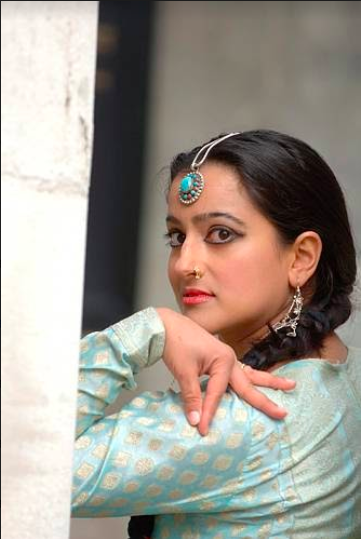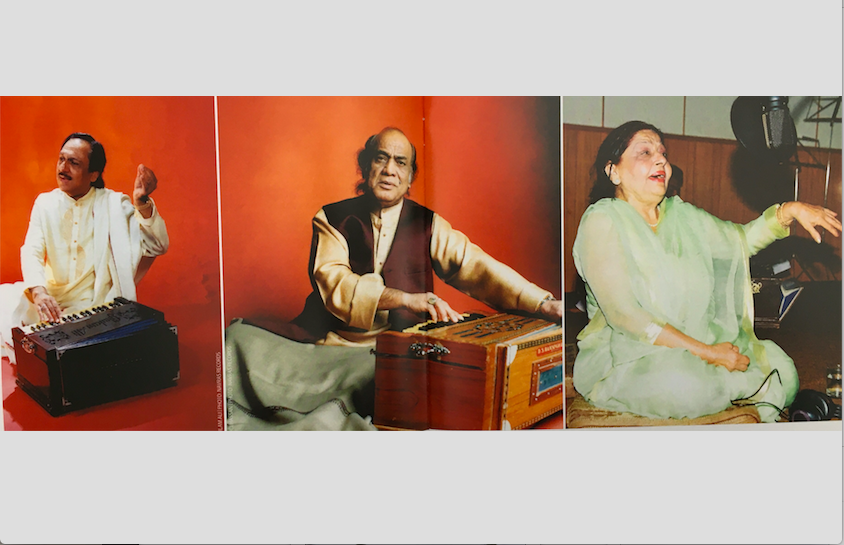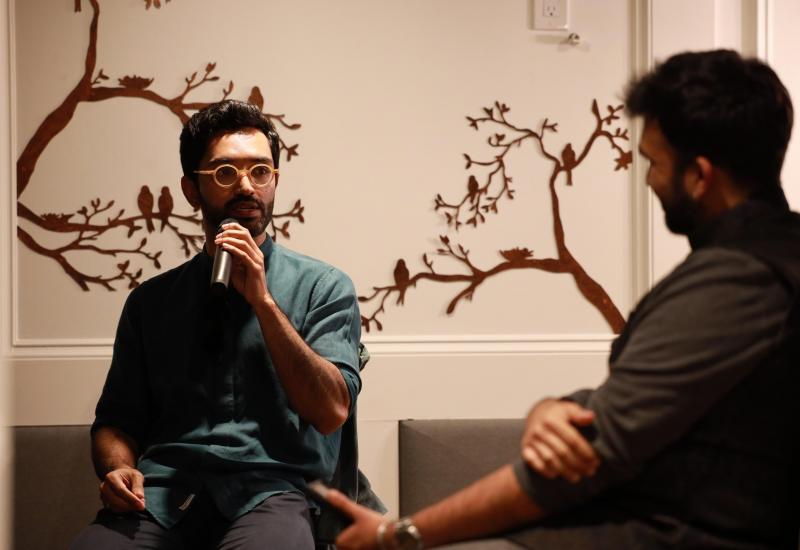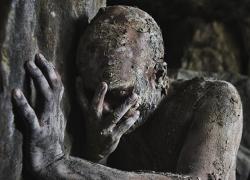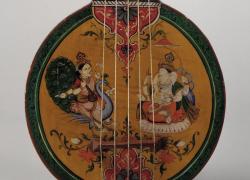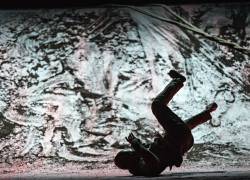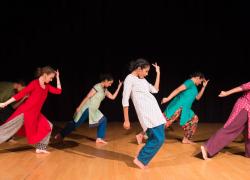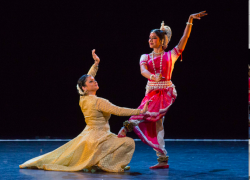The Ghazal – A Marriage of Poetry and Music
Waqt ki qaid mein zindagi hai magar
Chand ghadiyan yehi hain jo aazad hain
Life is trapped in time’s prison but
These are the few moments that are free
(from Fayyaz Hashmi’s ‘Aaj Jaane Ki Zid Na Karo’)
Ken Hunt elucidates for us the rich and continuing history of this poetic and lyric form, popular through generations.
First published in Pulse 132, Spring 2016
The article following, 'Dancing to Poetry', was also published in the same issue.
Top image: Ghulam Ali (Navras Records), Mehdi Hassan (Navras Records), Farida Khanum (Sachal Music)
GHAZAL IS ONE of the brightest jewels in the crown of Indian and Indo-Pakistani literature. Associated particularly but not exclusively with the north of the subcontinent, in the popular imagination this poetic form of literary ambition and attainment is often married to music. It arose from the Muslim literary traditions of Persian and Urdu and that heritage’s commingling with the Hindu world. In its Hindustani-language incarnation – once upon a time today’s Urdu and Hindi were lumped together for census purposes as Hindustani – it has proven resilient and adaptable in ways that would have delighted the music director Naushad Ali. Naushad’s post-Partition blend of musical idioms helped elevate Pakeezah (Pure of Heart), Mughal-e-Azam (Emperor of the Mughals) and Mother India to the nation’s highest cinematic pantheon.
An exchange in the Lok Sabha – the lower house of the Parliament of India – illustrates how ingrained ghazal had grown immediately after Partition. During an impassioned debate in 1956 about the proposed reorganisation of Indian states on linguistic grounds, C.D. Deshmukh, Jawaharlal Nehru’s Minister of Finance, quoted Urdu verse. Nehru’s response was a ghazal couplet from the poet Akbar Allahabadi, the pen name of Syed Akbar Hussain Rizvi. “A mere sigh, and we get a bad name,” countered Nehru. “He commits murder, and no one comments.”
Ghazal, one of the pre-eminent poetic forms in the Urdu language, was once the cornerstone of Islamicate song in the subcontinent. Arguably qawwali has since eclipsed its importance in the popular consciousness – unsurprising given the decline of Urdu comprehension in India. Nevertheless, it still remains a potent and driving force in light classical and popular song. Its name is synonymous with the vocalists Begum Akhtar, Iqbal Bano, Farida Khanum, Mehdi Hassan, Ghulam Ali and the husband-and-wife partnership Jagjit and Chitra Singh, whose 1977 LP The Unforgettables ushered in a New Age of ghazal.
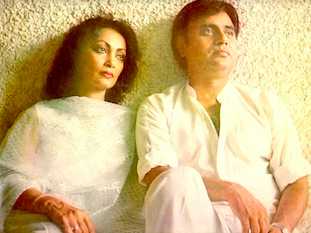
Photo: Jayesh Seth
Appropriated by the Bombay and Lahore film industries, the filmi ghazal genre became hugely popular. Indicative of that, Mohd Rafi’s 1963 Gramophone Company of India LP anthology Ghazals from Films cherry-picked a dozen tracks from a dozen different flicks.
Aside from the flim-flam, as a literary form, down the centuries ghazal irrigated the imaginations of many literary giants. The grand fabric of ghazal interweaving includes the Persian master poets Rumi and Hafez, the last great poet of the Mughal Era Ghalib, and the German Enlightenment poet and man-of-letters Johann Wolfgang von Goethe. In more recent times it fed the work of the Raj-era poet Muhammad Iqbal, Bengal’s multi-talented ‘Rebel Poet’ Kazi Nazrul Islam, and Pakistan’s Faiz Ahmed Faiz who made it a vehicle for political statements. Special mention needs to go to the Kashmiri poet Agha Shahid Ali who, aside from translating Faiz Ahmed Faiz and befriending Begum Akhtar, also penned ghazals in English and wrote the contextual introduction for the 2000 anthology Ravishing DisUnities: Real Ghazals in English.
There can be no doubt that there is an intellectual heft to ghazal. Ghazal itself is a continuously replenished lyrical well. In terms of weightiness, gravitas or introspection, it might be likened to the sonnet. It is a series of self-contained couplets in an AA, BA, CA, DA (and so on) rhyme scheme, each of which delivers a succinct idea. In terms of succinctness ghazal is much like Japanese haiku but without haiku’s bondage gear of seventeen syllables. Sequentially, each couplet forges another link in a chain of discrete thoughts or ideas. Couplet by couplet, the narrative whole or sentiment advances. More recent history, however, revealed a trend for couplets to be like moons in independent orbits around a planetary body.
In a ghazal, what sounds textually like a tale of love is frequently open to multi-tiered or plausible deniability interpretation. ‘Love’ can be ambiguous and sheer like a silken scarf passing through a ring: it flits between the sacred and the profane. A reference to ‘the Beloved’ – a common occurrence – may well stand for the supreme entity or simply a lower-case beloved or mere lover. The explicit is rarely desirable. It represents music and poetry from a different time, from a period before the slow creep of religification. Unlike the relatively out-of-favour sonnet form, ghazal remains totally in the present thanks to its modern-day literary, popular or political manifestations. Down the path, down the years, ghazal has come to represent toleration.
The poet and lyricist Gulzar, who regularly collaborated with Jagjit Singh, made an astute distinction: “In a poem and a lyric, the major difference is that a poem is a personal expression of the poet, whereas in a lyric, the expression is primarily that of the character arising out of the situation of the film story. A poem is not necessarily singable, whereas a lyric has to be set to music – often adjusting the metre of the verse for the musical composition. In a literary poem, that would be ungrammatical.”
For an example par excellence of when it comes to blending both ghazal’s literary and popular strands, Fayyaz Hashmi’s ‘Aaj Jaane Ki Zid Na Karo’ (‘Please don’t insist on leaving today’) stands out. Like Begum Akhtar before her, Farida Khanum has been hailed Malika-e-Ghazal (‘Queen of Ghazal’) and while the song has been covered by others, Habib Wali Mohammad and Asha Bhosle included, Farida Khanum owns it. Even to someone with no or only fragmentary knowledge of Urdu, the way she pitches the longing in the song is revelatory. She returned to sing it for the finale of Coke Studio’s Season Eight. Televised in October 2015, as the footage shows, the passage of time had turned one particular ghazal into a very different piece of sung literature.
Farida Khanum 'Aaj Janne Ki Zid Na Karo'
https://www.youtube.com/watch?v=KDJL2FyRDeA
Dancing to Poetry
Just as translating a poem from one language to another is a challenge, interpreting a ghazal through kathak makes parallel demands of the dancer in terms of understanding and expression. We asked kathak dancers about their favourite ghazals and how and when they may have used them in their performance.
Aditi Mangaldas
Unfortunately I have never worked with the ghazal genre, at least that I can remember. I rarely even listen to ghazals. Till now I have found them too sentimental and somehow this doesn’t quite work for me…
Nahid Siddiqui
Ghazals can be abstract in their nature; when portrayed in kathak they can be difficult to express as they are very subtle and have hidden meanings, which challenge the dancer’s imagination. I have performed ghazals many times and love to express the subtleties and nuances that are purely cultural and learned by living in the rootedness of language and expression of our culture.

Pranav Yajnik
To me, ghazal is a poetic form characterised by a series of couplets with a strict rhyme and refrain scheme; it comprises couplets that can stand alone, but taken with the others, form part of a wider theme. It typically deals with individual preoccupations, occasionally straying into the relationship between the human and the divine. It ranges widely in tone from banal to abstractly philosophical. As with any text, reading and listening to ghazal prompts a response in the audience. It is by examining the threads of one’s thoughts knitting together as we experience the text that we are led into new interpretations of what the text offers. The often multi-layered nature of ghazal means that our minds must work even harder to ‘read’, holding many different meanings simultaneously. That is a valuable exercise.
Can you quote lines (with translation) from a favourite ghazal?
Urdu ghazals suffer in translation because they are very dense, compressing a lot of meaning (and sometimes more than one meaning) into a very compact space, but I will do my best:
Koi dam ka mehmaan hoon, ai ahal-e-mehfil
charaag-e sahar hoon, bujha chaahta hoon. (Allama Iqbal)
‘O people of the assembly, I am a guest for but a few moments,
Like the candle just before dawn, I long to be put out.’
Have you performed to a ghazal?
Although I’ve worked on developing abhinaya to ghazal, I’ve never performed it. I find myself drawn to ghazals covering subjects at the abstract end of the spectrum and consequently, one needs to have an extremely strong sense of interpretative, narrative and expressional ability to convey successfully to the audience an abstract concept which does not easily translate into the ‘conventional language’ of kathak abhinaya.
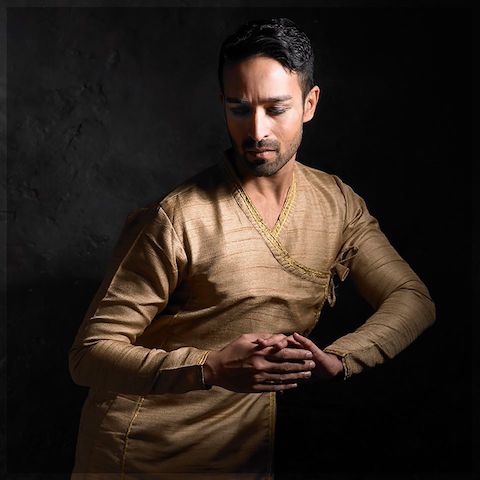
Sonia Chandaria
My Guru, Sujata Banerjee, introduced me to performing ghazals as a core part of my abhinaya training while pursuing the ISTD Intermediate Kathak Vocational Dance Exam. The more I expose myself to ghazals and understand the poetic lyrics, engulfed with metaphors, the more I enjoy the multiple layers of meaning I can create and explore how to portray them through my dancing; and I continue to aspire to perform them with more depth and maturity.
Can you quote lines from a favourite ghazal?
Tere khushboo mein base khat main jalaata kaise
Pyaar mein dube huye khat main jalaata kaise
Tere haathon ke likhe khat main jalaata kaise
Tere khat aaj main ganga mein baha loon
Aag behate huye paani mein lagaaaya hoon…
(sung by the late Jagjit Singh)
A possible translation:
‘Letters steeped in your fragrance, how could I ever burn?
Letters drowned in your love, how could I ever burn?
Letters scribbled by your hand, how could I ever burn?’
Literally, the next line translates as ‘today I set afloat all your letters in the Ganges’ but I think of it as ‘I’ve cried so much, my tears have washed away your (writing on the) letters’. And the final line literally suggests the letters are set afloat in waters blazing in fire. For me, the fire is a metaphor for the love/passion that the protagonist feels. So, while the protagonist might be able to let go of the letters, the love they feel burns like fire (and perhaps eventually, with enough tears, may temper down…).
Sonia performed a ghazal to the live vocals of Debipriya Sircar as part of Navodit, a platform developed by Akademi for emerging artists.
In the ghazal I portray a woman who revels in how peaceful and tranquil it feels to be alone. Yet she feels restless. Upon further introspection she realises it is the rumbling thunder-clouds outside that seem to be catalysing that feeling. As she enjoys the feeling of the raindrops outside, she sheds a few sneaky tears and it helps to calm her restlessness.
Tanha tanha, tanha ye dil hain
Sawan ki ghata bayshumaar hain
Nanha nahna sa, boond ki pyasa
Aankhon ka paani, jawaab hain!
‘Lonely, my heart is lonely,
The monsoon (rain) outside is ceaseless
Yet my eyes thirst for a tiny teardrop.’
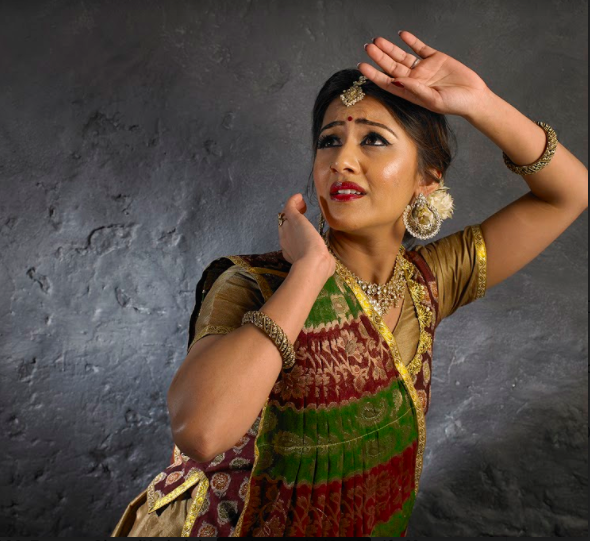
Kajal Sharma
I have always had a great love for the ghazal, as a practitioner of vocal music, and of kathak, as a performing artist, but I have never been attracted to perform to ghazals in my kathak routines – my own attachment with kathak is to the devotional. When I see people performing on ghazals without realising that a ghazal demands a high level of maturity in abhinaya I feel very uncomfortable. Ghazals cannot be treated in the same way as thumris or bhajans. Ghazal lyrics are often about sharaab (wine) and shabaab (youthfulness). The dancer needs to be comfortable with the lyrics and understand them, otherwise the effect can be coarse.
These are lines from two favourite ghazals:
Muzhko deewana samazhte hai
Tere shahar ke log
Mere daaman se ulazhte hai
Tere shahar ke log.
‘They think I am crazy, the people of your city (i.e. the people around); they are putting hurdles in my way, the people of your city.’ (My guruji Pandit Birju Maharajji used to sing this very often, after our classes in Kathak Kendra, Delhi, in the early 1980s.)
Baichaian bahut firna
Ghabraye huye rahana
Jis shahar mai bhee rahana
Uktaye huye rahana. (Sung by Ghulam Ali)
‘Wherever you are, you are restless,
Wherever you are, you are anxious,
Wherever you go, you are listless.’
(The meaning of ‘uktaye’ is literally ‘boredom’ but can be interpreted rather like the French ennui. Trans. Sudipta Roy)
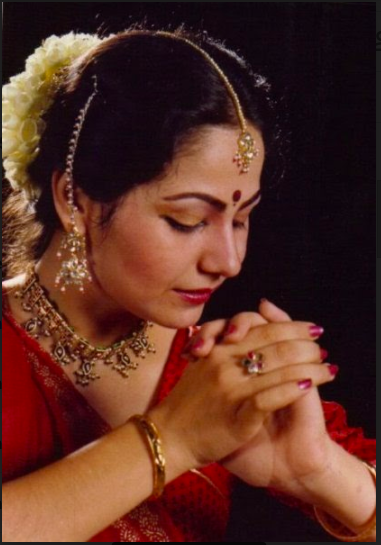
Sonia Sabri
Can you quote some lines from a favourite ghazal?
Shola Tha by Ahmed Faraz
Shola tha jal bujha huun hawaayein mujhe na do
main kab ka ja chuka huun sadaayein mujhe na do.
jo zahar pii chuka huun tumhin ne mujhe diya
ab tum to zindagi ki duaayein mujhe na do
aisa kabhi na ho ke palat kar na aa sakuun
har baar duur ja ke sadaayein mujhe na do.
‘Once a flame I am nothing but a dying ember now, do not try to rekindle me,
I am long gone, do not call out to me.
The poison I took was given by none other than you,
At least you cannot pray for my life now.
Lest it happens that I cannot return next time,
Don’t call me back after going further away from me.’ (Trans. Jaya Roy)
Have you performed to a ghazal? Tell us something of how you interpreted it.
Yes. I have performed to and still do to a Persian ghazal. Initially it was quite a challenge to interpret because it’s not a language I am familiar with and I do not have the experience of the sadness of separation from a beloved in a season that symbolises new beginnings and joy. I had to do several readings with Sarvar (tabla artist, composer, my hubby and walking resource centre!), who has studied the Persian language, to begin to understand the essence of the composition as well as the cultural contexts, what the poet wished to convey and also the rhythmic structure. Following my researches, numerous hours are spent at the mirror creating, defining and redefining.
Abhinaya techniques from kathak and theatre begin to form the depiction of the literal, the metaphorical and the poetic or unsaid. What is exciting for me is that the ghazal is never a fixed choreography for me because I find my personal experiences inform my execution of the ghazal so it can be different each time I dance it in the studio or performance.
